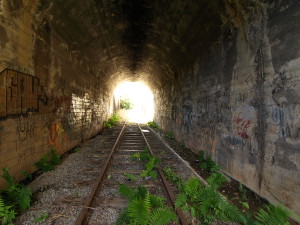I mostly ignored the initial twitterings about a supposedly secret train laden with gold and other Nazi-looted treasures that was buried somewhere near Wrocław, formerly Breslau, in Poland. My reasons were straightforward: just like supposed sightings of the Gardner Museum heist art, or the Amber Room, the story had all the hallmarks of a fable being peddled by someone who, perhaps not coincidentally, was suggesting that they be paid something for their trouble. Whether this is the next Gurlitt saga or just Al Capone’s vault, it’s too early to tell.
(No gold train here)
I am still quite skeptical, but while I was on vacation last week Polish officials took the story up a notch by stating that they believed that had found something near a rail line in Walbrzych. On August 28, 2015, Deputy Culture Minister Piotr Zuchowski stated at a press conference that he is “99 percent sure” that the government had located the train allegedly loaded with gold, gems, and perhaps artwork that was buried as the Soviet Red Army encircled Breslau in the last months of World War II. "The train is 100 meters long and is protected," Zuchowski said. He went on:
The fact that it is armored indicates it has a special cargo. . . . We do not know what is inside the train. . . . Probably military equipment but also possibly jewelry, works of art and archive documents.
Zuchowski also revealed that the information about the train’s location came “"in a deathbed confession from a person involved in concealing it." Not at all surprisingly, authorities have now had to cordon off the area from gold seekers and amateur archeologists, and there was even a fire nearby.
The location of this potential find also invites almost limitless possibilities. Consider: Breslau was at the intersection of the German and Polish speaking worlds for centuries, falling under the auspices of, among others, Bohemia, the Kingdom of Poland, the Duchy of Silesia, the Holy Roman Empire, the Hanseatic League, Prussia, and the German Empire. Breslau’s centuries’ old Jewish population was targeted as everywhere else (David Friedmann, the owner of the recently restituted Max Liebermann painting Riders on the Beach, among them).
It was not until late in World War II that the city felt dramatic effects of the war, as Polish and German (from farther east in East Prussia) refugees fled from the crushing of the Warsaw Uprising and in advance of the Red Army respectively. Fueled in part by the fate of Königsberg in East Prussia, Nazi Gauleiter Karl Hanke declared Breslau a “fortress city” to be held at all costs. The results were predictable, with Hanke finally lifting the prohibition on evacuation just in time to allow some 20,000 women and children out into the snow to freeze to death in January, 1945.
This history explains the plausibility and in some ways the lure of the mythical hidden train. By the beginning of 1945, the Red Army’s habits in conquered territories were no secret, and time had run out to go anywhere else. And, given Breslau’s relatively secure location until that point, it could have been a receiving point for looted property from literally every corner of Nazi-occupied Europe. It also supplies a platform to plug in theories that have failed elsewhere: right on cue, theories that the amber-paneled “Amber Room” (Bernsteinzimmer) that was last seen before the fall of Königsberg might be in the train. Before you get too excited, people were speculating a couple years ago that the Amber Room might be in Cornelius Gurlitt’s apartment. Given the fragility of amber, and what happened in Königsberg, the Amber Room was likely pulverized 70 years ago.
So what to make of all this? On the one hand, as my good friend Markus Stoetzel tweeted “Instead of getting excited about ghost trains and secret treasures, draw attention on what's known but yet unsolved.” Amen.
And yet, in a post-Gurlitt world, it cannot be dismissed out of hand. So for now, here are my suggestions about how to keep an eye on this story:
1) Wait for real news. So far it appears that there may be a train underground in Poland. That’s not very much. And it appears that someone may have “confessed” to having hidden it. But there too, what this person confessed to having hidden is pretty murky. And there is absolutely no objective information about what is in this underground cavity, just that it is there (probably).
2) Ignore claimed valuations. If and/or when a train is unearthed, expect fantastical numbers in the billions of dollars about what’s inside. That will not inform anything about where it came from.
3) Keep a critical eye on action in response. Will we see task forces that do nothing? Or will we see a real effort to sort out whatever gets found?
4) Above all, consider the source of new developments. There are many competing agendas out there.
Presumably at some point, something will get dug up. And then it may get very interesting.




